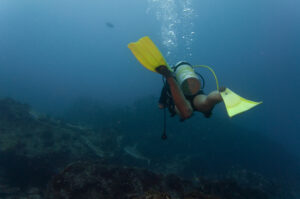What is a Dry Bag?
A dry bag is a specialized type of bag designed to keep its contents dry in environments where water exposure is a concern. Primarily used in water-related activities such as kayaking, boating, and scuba diving, dry bags are essential for protecting valuable items from water damage. Their construction typically involves waterproof materials and sealing mechanisms that prevent water from penetrating the bag, thus ensuring the safety of the items inside. In the context of scuba diving, dry bags are particularly important for keeping gear, personal belongings, and sensitive electronics dry and functional throughout the diving experience.
History and Development
The concept of keeping items dry while engaging in water activities has been around for centuries. Early forms of waterproof storage involved simple methods like wrapping items in oilcloth or animal skins, which offered basic protection against moisture. As the need for more reliable waterproofing solutions grew, especially with the advent of modern water sports, the development of dry bags began to take shape.
The 20th century saw significant advancements in materials science, which directly influenced the evolution of dry bags. The introduction of synthetic materials like vinyl and nylon revolutionized the design and functionality of dry bags. These materials provided better waterproofing and durability compared to traditional methods. The invention of the roll-top closure, a method where the top of the bag is rolled down and then secured with buckles, was a game-changer, providing a reliable seal that kept water out.
As scuba diving became more popular in the mid-20th century, the demand for specialized gear, including dry bags, increased. Manufacturers began to focus on creating bags that could withstand the harsh conditions of underwater environments. Innovations in sealing technologies, such as the development of waterproof zippers and valve systems, further improved the effectiveness of dry bags. Today, dry bags are an integral part of scuba diving gear, offering divers peace of mind knowing their belongings are protected.
Types of Dry Bags
Dry bags come in various types, each designed to meet specific needs and preferences. The most common type is the roll-top dry bag, which is favored for its simplicity and effectiveness. These bags typically have a cylindrical shape and are closed by rolling down the top several times and securing it with a buckle. This design is particularly effective at keeping water out and is popular among scuba divers for storing essential items.
Another type of dry bag is the zipper seal dry bag. These bags use waterproof zippers to create a seal that keeps water out. While they can be more convenient to open and close compared to roll-top bags, they require careful maintenance to ensure the zipper remains effective. Zipper seal dry bags are often used for storing smaller items that need quick access, such as cameras or mobile phones.
Dry bags are made from a variety of materials, each offering different levels of protection and durability. Vinyl is a common material used for its waterproof properties and ease of cleaning. Nylon, often coated with silicone or polyurethane, offers a lighter and more flexible alternative while still providing excellent waterproofing. Rubber dry bags, though less common, offer superior durability and are often used in more rugged environments.
The size and capacity of dry bags vary widely, catering to different needs. Small dry bags, often referred to as dry pouches, are used for items like wallets, keys, and mobile phones. Medium-sized bags are suitable for storing clothing and smaller gear, while large dry bags can hold bulky equipment or multiple items. For scuba divers, choosing the right size and type of dry bag is crucial to ensure they can protect their gear and personal items effectively.
Features and Technologies
Modern dry bags incorporate a range of features and technologies designed to enhance their functionality and usability. One of the key features is the waterproofing method used in the construction of the bag. Roll-top closures, as mentioned earlier, are highly effective at creating a watertight seal. Waterproof zippers, though requiring more maintenance, offer the convenience of quick access while still providing reliable protection against water ingress.
Innovations in materials have also played a significant role in the development of dry bags. High-performance materials like TPU (thermoplastic polyurethane) offer a combination of flexibility, durability, and waterproofing. These materials are often used in conjunction with welded seams, which eliminate the need for stitching and further reduce the risk of leaks. Some dry bags also feature reinforced bottoms and handles, enhancing their durability and making them easier to carry.
Another important feature is the inclusion of valve systems. Some dry bags are equipped with valves that allow air to be expelled from the bag after it has been sealed. This reduces the bulkiness of the bag and makes it easier to pack and carry. Valve systems are particularly useful for scuba divers who need to optimize their gear for underwater transport.
Comparing traditional and modern dry bags reveals significant improvements in design and functionality. Traditional dry bags often relied on basic materials and simple sealing methods, which could be prone to leaks and wear. In contrast, modern dry bags benefit from advanced materials and construction techniques that offer superior protection and longevity. For scuba divers, these advancements mean they can rely on their dry bags to protect their gear and personal items even in the most challenging conditions.
Practical Applications in Scuba Diving
In the context of scuba diving, dry bags serve a variety of essential functions. One of the primary uses is to protect gear and personal items from water exposure. Divers often use dry bags to store items like clothing, towels, and electronic devices that need to stay dry throughout the dive. By keeping these items in a dry bag, divers can ensure they remain usable and in good condition.
Dry bags are also used to protect sensitive equipment that divers need to take with them underwater. For example, underwater cameras and lights are often stored in dry bags to prevent water damage during transport to and from the dive site. Some dry bags are designed specifically for this purpose, offering padded compartments and additional protection for delicate gear.
In challenging diving environments, such as caves or wrecks, dry bags can be indispensable. These environments often involve tight spaces and rough conditions, which can put gear at risk. Using a durable dry bag ensures that essential items are protected and can be easily transported through these environments. Case studies of divers who have successfully used dry bags in such conditions highlight their importance in ensuring a safe and successful dive.
Choosing the right dry bag for different diving conditions involves considering factors such as the type of closure, material, and size. For instance, a diver planning a long trip with multiple dives may opt for a large roll-top dry bag made from heavy-duty materials to store their gear. On the other hand, a diver needing quick access to a camera might prefer a smaller zipper seal dry bag. Understanding the specific needs and conditions of the dive helps in selecting the most suitable dry bag.
Maintenance and Care
Proper maintenance and care of dry bags are essential to ensure their longevity and effectiveness. After each use, it is important to rinse the dry bag with fresh water to remove any salt, sand, or dirt that could damage the material or affect the seal. Allowing the bag to air dry thoroughly before storing it helps prevent mold and mildew growth.
Regular checks for wear and tear are crucial in maintaining the integrity of the dry bag. Inspecting the seams, closure mechanisms, and overall material for signs of damage can help identify potential issues before they lead to leaks. If a dry bag develops a small puncture or tear, repair kits are available that allow for quick and effective fixes, ensuring the bag remains waterproof.
Storing dry bags properly when not in use also contributes to their longevity. Keeping them in a cool, dry place away from direct sunlight and extreme temperatures helps preserve the material and prevents degradation. For bags with waterproof zippers, applying a lubricant specifically designed for zippers can keep them functioning smoothly and extend their lifespan.
Understanding common issues with dry bags and how to address them is part of effective maintenance. For example, if a roll-top closure becomes difficult to secure, it might indicate that the material has become stiff or the sealing surfaces are dirty. Cleaning and softening the material can restore its functionality. Regular maintenance routines and prompt attention to any problems help ensure that dry bags continue to provide reliable protection.
Environmental Considerations
The production and disposal of dry bags can have environmental impacts, particularly due to the materials used in their construction. Many dry bags are made from synthetic materials like vinyl and nylon, which can take a long time to decompose and may release harmful chemicals into the environment. Considering the environmental footprint of dry bags is important for promoting sustainable practices in their use and production.
Manufacturers are increasingly exploring eco-friendly alternatives and innovations to reduce the environmental impact of dry bags. This includes using recycled materials in their construction and developing biodegradable options. For example, some companies now offer dry bags made from recycled plastics, which help reduce waste and the demand for new raw materials. Biodegradable dry bags, while still a developing technology, offer the promise of reducing long-term environmental impacts.
Consumers can also contribute to environmental sustainability by choosing dry bags that are designed for durability and longevity. Investing in a high-quality dry bag that lasts for many years reduces the need for frequent replacements and minimizes waste. Additionally, proper maintenance and care of dry bags, as discussed earlier, can extend their lifespan and reduce their environmental footprint.
Disposing of dry bags responsibly is another important consideration. When a dry bag reaches the end of its useful life, it should be recycled if possible. Some manufacturers offer take-back programs where old dry bags can be returned for recycling. If recycling is not an option, disposing of the dry bag in accordance with local waste management guidelines helps minimize its environmental impact. By being mindful of these environmental considerations, both manufacturers and consumers can contribute to more sustainable practices in the use and production of dry bags.
Key Takeaways
Dry bags are essential for protecting gear and personal items in water-related activities, especially scuba diving. They have evolved significantly over time, with modern dry bags incorporating advanced materials and technologies for superior waterproofing and durability. Various types of dry bags cater to different needs, from small pouches to large roll-top bags. Proper maintenance and care ensure their longevity, while environmental considerations guide more sustainable use and production practices.
Choosing the right dry bag and maintaining it properly can greatly enhance the diving experience by ensuring the safety and protection of valuable items.

















